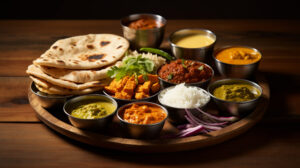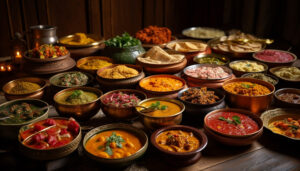
🌶️ Spices, Stories & Savoring Home: A Soulful Journey Through Indian Cuisine
Namaste, dear reader—
Close your eyes. Imagine the hiss of mustard seeds in hot oil. The floral breath of cardamom rising from a bubbling pot of chai. The soft rustle of a banana leaf unfurling beneath a festive meal.
That’s the first bite of Indian food—not through your mouth, but through your memory.
Because in India, food isn’t just nourishment. It is legacy. It is ritual. It is a language spoken across generations, with every dish carrying echoes of laughter, loss, celebration, and belonging.
Join me, as we journey across this vast, flavorful mosaic of India—one spice, one story, one spoonful at a time.
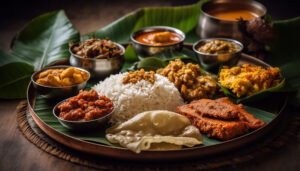
🥘 The Thali: A Philosophy of Balance and Abundance
A traditional Indian thali is more than a meal—it’s a metaphor for life. Diverse, dynamic, and balanced.
-
In Punjab, the land of mustard fields and soulful music, food is abundant and generous. Imagine a copper bowl of dal makhani, black lentils slow-cooked overnight, laced with cream and love. Add a buttery naan and a tall glass of lassi—rich, cooling, indulgent.
-
Further south in Kerala, cuisine is a coastal symphony. A clay pot simmers with meen moilee—fish bathed in coconut milk, green chilies, and curry leaves that pop like monsoon thunder.
-
In the poetry-laced kitchens of Bengal, food is an art form. Gobindobhog rice perfumes the air. Mustard oil sharpens the tongue. And sweets like sandesh and mishti doi offer a sweet sigh to end every meal.
-
In Gujarat and Rajasthan, scarcity becomes creativity. You’ll taste sweet-spicy theplas, tangy dal dhokli, and fiery ker sangri—sun-kissed desert flavors made to last.
-
And in the misty valleys of the Northeast, wild herbs, smoked meats, bamboo shoots, and fermented wonders paint a culinary landscape that’s lesser known, but deeply rooted in earth and soul.
🍽️ A thali isn’t just food—it’s India on a plate. It respects season, region, and spirit. And it always leaves you full—in body and in heart.
🌿 The Masala Dabba: Where Magic Begins
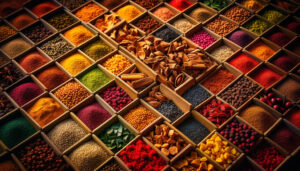
Indian cooking begins not with ingredients, but with intention. A pause. A prayer. A plan.
Then comes the masala dabba—the round spice box that holds the heartbeat of the kitchen.
-
Turmeric: A golden dust of purity, medicine, and protection. It’s the sun in every curry.
-
Coriander: Bright and citrusy when raw, grounding and nutty when toasted.
-
Cardamom: A whisper of royalty—sweet, mysterious, floral.
-
Cumin: Earthy, ancient, grounding. Toasted just right, it sings.
-
Asafoetida (hing): Sharp, funky, essential. Like the unsung hero in every vegetarian dish.
Each cook has their own rhythm: the oil must shimmer, the seeds must dance, the onions must brown just so. This alchemy of heat and spice is not a recipe—it’s instinct, learned from the stories in a mother’s eyes, not from a book.
🍛 Khichdi: The Most Honest Food You’ll Ever Eat
There are days when all you want is quiet. For those days, there’s khichdi.
No food in India carries as much emotional gravity. Rice and lentils, cooked together until they no longer remember where one ends and the other begins. A dollop of ghee. Maybe a slice of pickle. Some crispy papad on the side.
It’s what we feed babies, the sick, the grieving—and ourselves, when we’re tired of performing for the world.
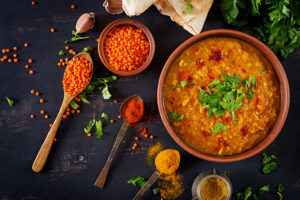
Khichdi is more than comfort food. It is the taste of surrender, of stillness, of being held.
🛺 Street Food: India’s Theatrical, Joyful Chaos
If khichdi is a lullaby, street food is a rock concert.
-
Pani puri: A burst of tamarind, mint, spice, and surprise—all in one mouthful.
-
Chole bhature: Puffy bread and spiced chickpeas—the ultimate North Indian power couple.
-
Pav bhaji: Street symphony—mashed vegetables, butter, bread, speed, noise, heart.
-
Kathi rolls: Bengal’s gift to the world—smoky kebabs and spiced onions, hugged in flaky paratha.
-
Jalebi: Amber spirals soaked in syrup—crispy on the outside, soft within, like most of us.
Indian streets serve food with no pretension, but all the passion. And somehow, every bite carries the flavor of freedom.
🥭 Seasons, Spirits, and Sacred Offerings
In India, we don’t just eat by season—we live by it.
-
Summers mean raw mango chutneys, cool chaas, and endless aamras.
-
Monsoons bring pakoras and steaming masala chai—rain on tin roofs and spice on the tongue.
-
Winters? Think sarson da saag, gajar ka halwa, and smoky bonfires under starry skies.
And food is woven into the sacred. From Diwali laddoos and Eid’s biryani, to Onam’s sadhya and Navratri’s sattvik thalis, every dish is a ritual, every festival a flavor.
🪔 Here, food is prasad, not just product. It’s made with both hands—and heart.
🧾 Final Bite: Come Home to Flavor
To eat Indian food is to taste the soil, the soul, and the centuries. It’s to share a table with history, family, and strangers who soon become friends.
You don’t need to speak a single Indian language. The food will speak to you.
So take a seat. Scoop the dal with your fingers. Let the rice mix with curry. Close your eyes. And listen.
You’re not just eating.
You’re home.
💬 Your Turn
What’s your Indian comfort dish? The one that brings tears, smiles, or both? Was it made by a grandmother? Found at a street stall? Discovered far from home?
Share your story in the comments—or tag me in a photo. I’d love to feature your memory in an upcoming blog post. ❤️
